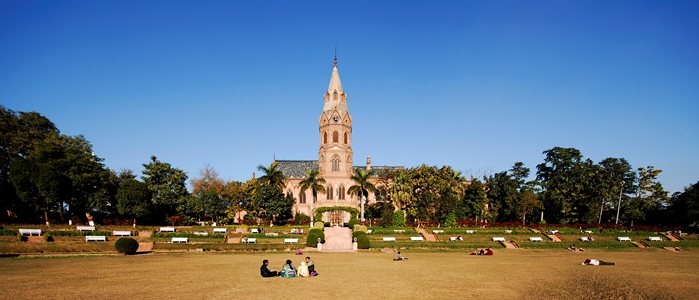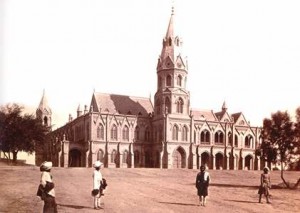Government College Lahore or simply GCU, is synonymous with Lahore. Among the most famous of Lahore colleges, it is among the first educational institutions that were established in the Punjab. Generations of students have passed through its portals and attained eminent positions in all walks of life in Pakistan.
Although the establishment of a Central College at Lahore was sanctioned in 1856 with the condition that the teachers should be graduates of Oxford, Cambridge, Dublin or Durham, it was not until January 1, 1864 that the college opened its doors in the palace (haveli) of Dhian Singh/Khushal Singh, in Lahore’s Walled City.
In April 1871 the college moved to a large Bungalow near Anarkali. In 1873 its location was changed to another house called Rahim Khans Kothi. It was in 1876 that the college moved into the present building. The construction had started almost in mid 1872 and was completed in 1877. Situated in the heart of the city, the site is surrounded by main business and administrative areas, schools, colleges and Punjab University old Campus. Presently raised to the status of university, Government College University (GCU) site is located at the junction of the Mall and the Lower Mall and occupies a focal point.
The first principal was the famous Dr. G. W. Leitner whose name is closely attached to the College. In April 1871 the college moved to a large Bungalow near Anarkali. In 1873 its location was changed to another house called Rahim Khan’s Kothi.
When it was decided to move to more suitable premises, a site on an eminence north of the Soldier’s Garden (Gol Bagh) was selected, and a ‘picturesque building’, with a large central clock tower was constructed. That Gothic was the chosen style for the building is not surprising. Among the first major structures of Lahore, the missionary zeal frequently expressed by the Lawrence brothers (Henry and John Lawrence) no doubt had an impact on the architectural expression of the college.
The building was designed by W. Purdon, Superintendent Engineer, and constructed under the supervision of Executive Engineer Kannhaiya Lal. It was completed in 1877 at a cost of Rs. 320,000. A couple of years after its completion. Viceroy Lord Lytton presided over the convocation of ‘Punjab University College’ (1879) held in its convocation hall with its enormous height—”the great hall of the Lahore College, which was tastefully decorated and arranged for the occasion.” Lytton papers recorded that the event was witnessed by “a large number of ladies and gentlemen, European and Native.”
From the main road the main college building is seen above the landscaped terracing through the foliage of trees, presenting a picture postcard view. The Lahori brick is combined with sparing use of black Chiniot stone in the first floor columns as well as in the borders lining the openings. Pointed arches on the facade are accented with simple moldings, and the building is topped by a steeply sloping roof. According to Kannahiya Lal, the slate for the roof covering was acquired from Dalhousie Mountain hundreds of miles away.
The centre of the GCU main building is marked with an enormous entrance tower—a most impressive element representing the image of Government College. Placed on a 15′ high podium, and accessible from the garden by a wide flight of stairs, the tower rises to a total height of 176′. Divided into four distinct storey, it is terminated in the form of a spire. The battered sides of the octagonal tower carry quaint dormer windows, with its enormous clocks visible from great distances. The classrooms are accessed from a deep verandah which also provides protection from the strong Punjab sun.


